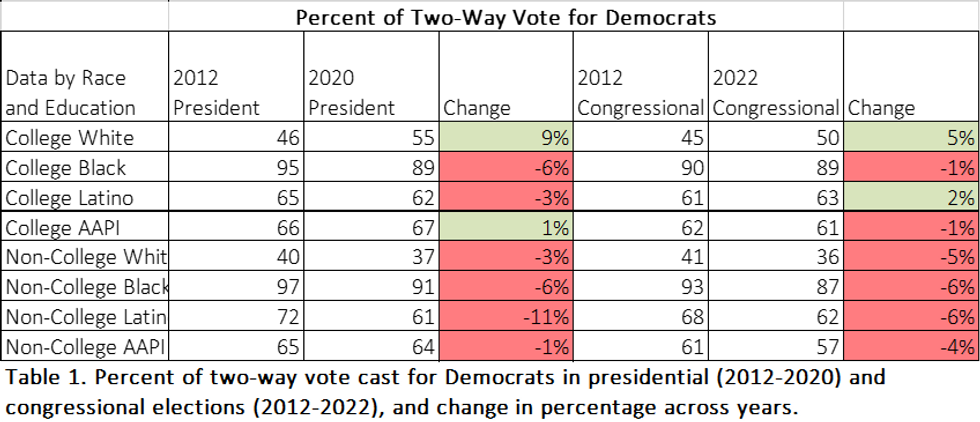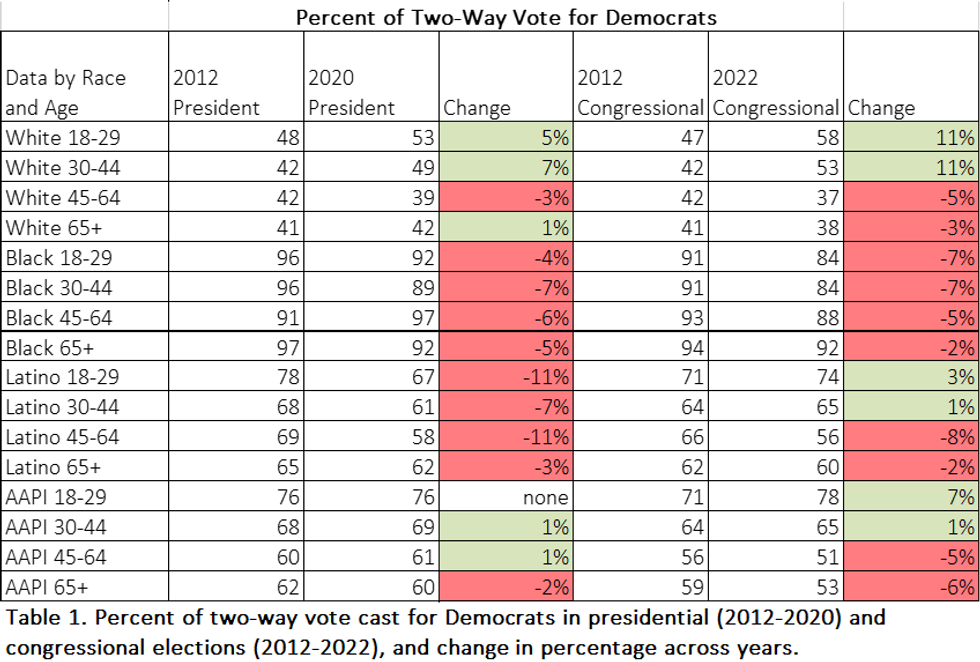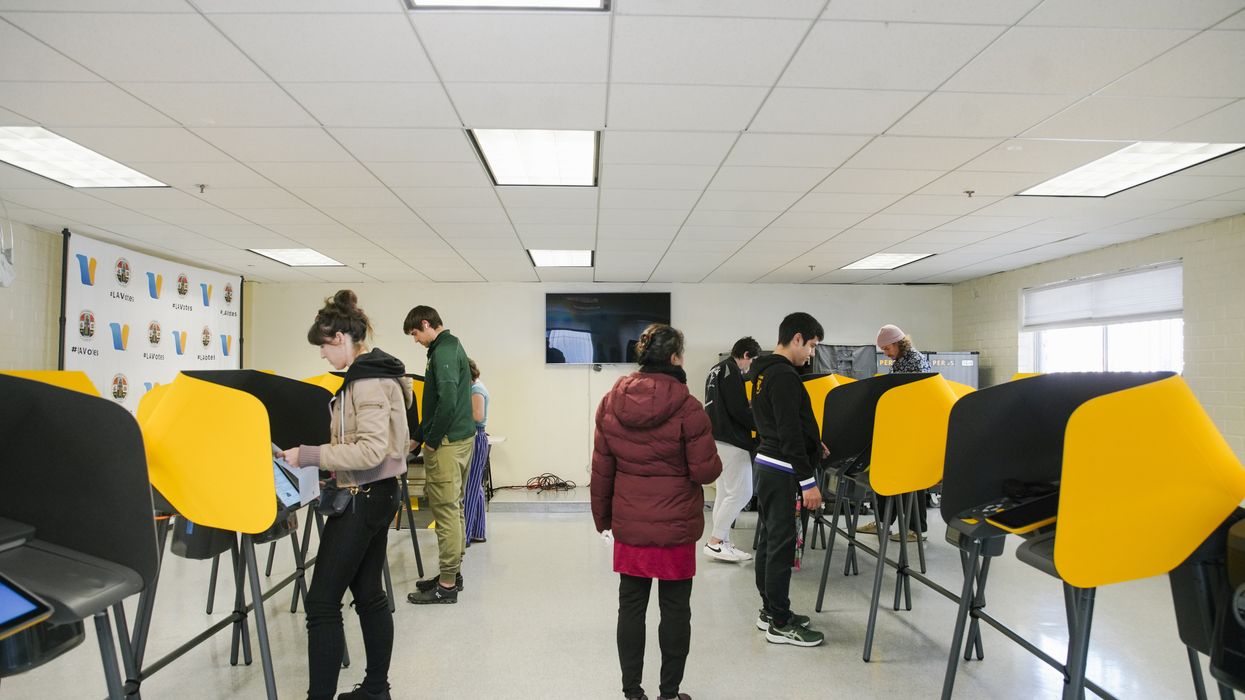Zimny-Schmitt works on a joint appointment between the Advanced Data Analytics & Tools Group in NREL's Strategic Energy Analysis Center and the Mobility team in the Transportation and Hydrogen Systems Center.
The Democratic polling and analytics firm Catalist has released an invaluable resource to analyze voter trends by demographic groups across the last three presidential elections (2012-2020) and last five congressional elections (2012-2022). When paired with more recent polling on the upcoming 2024 election, a comprehensive picture emerges of how different demographic groups are gradually, yet substantially, changing their voting patterns.
Catalist’s national crosstabs illustrate how Democrats have lost ground with nonwhite voters in almost every election over the past decade. A recent compilation of Times/Siena polls from 2022 and 2023 show that there is reason to believe this trend will continue in November, as Joe Biden leads Donald Trump by a margin of just 53 percent to 28 percent among registered nonwhite voters. Minority voters are crucial because they often provide the support needed to get either the Democrat or Republican across the line in close races.
To understand which voters are switching their partisan allegiances, we must look beyond race alone. We can find clues in education, where the percentage shifts are greater than the shifts observed solely using race. With the exception of college-educated white voters moving toward Democratic presidential and congressional candidates, virtually every other demographic group is shifting toward supporting Republican candidates.
 Catalist
Catalist
At a time when racially charged fights animate the political arena, from border control to affirmative action, an outside observer might wonder why the trends among nonwhite voters are not moving in the opposite direction. While issues like abortion access, threats to democracy and immigration reform comprise much of the rhetoric of Democratic leaders today, these issues may be less likely to rally support from Black and Latino voters, who tend to be more conservative than white Democratic voters and often do not have party-line views on many of the issues championed by the Democratic Party.
A final demographic variable to consider here is age. Among white voters, a growing generational divide in support for Democratic candidates is evident, but nonwhite voters did not exhibit the same pattern. Blacks in all age groups moved away from supporting Democratic candidates in presidential and congressional contests. Latinos in all age brackets moved away from the Democrats in presidential races, with the most pronounced shift among the youngest voters. Asians in all age groups saw virtually no change in support for Democrats in presidential elections, and in congressional elections, younger Asian voters moved toward Democrats while older Asian voters moved toward Republicans.
 Catalist
Catalist
An important trend emerges when combining data on race and age: The new support for Democrats is coming from younger white voters, who are only sometimes joined in their growing support by their young, nonwhite peers. While Democrats are gradually losing the support of older white people and minorities, its surge in support among younger white voters has kept the party above water. However, the more socially liberal policies the Democratic Party is championing to win the support of this group may be costing the party support among the multiracial working class, who are more socially conservative.
Squaring the age and race data from Catalist with more recent polling hints that these trends are likely to continue. Polling showcases Biden’s notable weakness among younger nonwhite voters relative to their older counterparts. To borrow from Nate Cohn, this generational divide is the most evident among Black voters, whose voters over 45 support Biden by a 75-point margin, while voters under 45 back him by only 59 percent to 14 percent. Any number of reasons can be speculated upon as to why this gap is so large, but the receding memories of the Democratic-driven civil rights movement and lower church attendance (which helped tie the Black community to the Democratic Party for decades) by the younger generations are solid guesses.
What should perhaps be more concerning to Democrats is what the Equis Research 2022 election postmortem on the Latino vote found. Fully 5 percent of Biden’s nonwhite voters now support Trump, including 8 percent of the Latino voters. Given the narrow margins that Biden carried in crucial swing states with large Latino populations, like Nevada and Arizona, this is concerning. The Democratic Party will need to consider the likely consequences of having a 2024 electorate that is likely to be whiter, younger and better educated than in election cycles past.
Sunbelt states with lower levels of educational attainment and higher nonwhite populations like Georgia, Arizona and especially Nevada may be tougher for Biden and down-ballot Democrats to win. Florida and Texas appear likely to continue drifting away from Democrats. On the other hand, the more educated and whiter states in the Northeast and Upper Midwest may offer the Democratic Party stronger electoral prospects.
Early hints of these trends were seen in the 2022 results, which saw strong Republican performance in the sunbelt, including the Nevada gubernatorial contest. Stronger Democratic performances were observed in races from roughly Maine to Minnesota, including the party’s nearly 5-point victory in the race for the open Pennsylvania Senate seat. Any number of circumstances may change before November, but from where both the short-term polling and the long-term trends stand now, the electoral coalitions of both parties seem poised to continue to evolve in the same direction they have for the past decade.




















 Shannon Gormley, Rhode Island Public Schools
Shannon Gormley, Rhode Island Public Schools Les Sinclair, Blue Ridge Area Food Bank
Les Sinclair, Blue Ridge Area Food Bank Elena Casillas Hoffman,
Elena Casillas Hoffman, 
 Darrious Hilmon, Executive Director, CAN-TV
Darrious Hilmon, Executive Director, CAN-TV